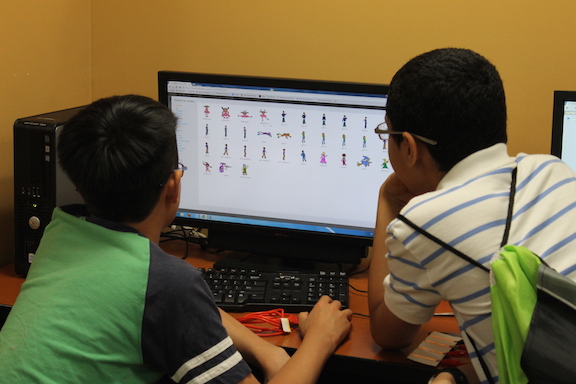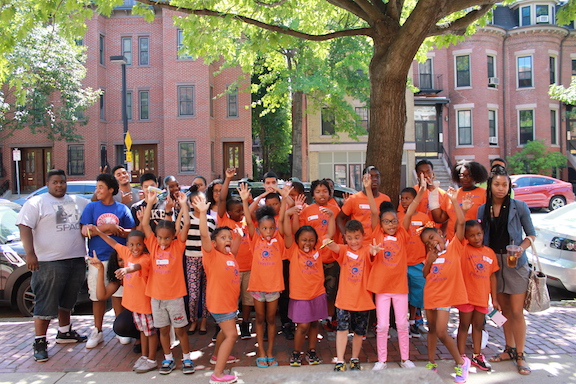This is a guest blogpost by our talented Tufts University Tisch Summer Fellow, Michelle Nguyen, who conducted research with Boston's Learn 2 Teach, Teach 2 Learn program. Annually, our teen youth teachers teach 700+ children at over 25 community organizations. We have high expectations that our youth always exceed. As our program name suggests, we also believe that learning is deepened when youth are engaged in teaching others. A brief introduction to our 13 year old program can be found in our 2015 Project Expo program: https://goo.gl/MCBUQL and https://goo.gl/UAu3Tr
“I saved the world...multiple times!”
a quote from Marc, a youth teacher, about what his favorite moment was at SETC

Hello, my name is Michelle Nguyen, a current senior studying Child Study & Human Development at Tufts University. I’m interested in bridging human development and innovative science education. Over the past summer I worked at the South End Technology Center at Tent City in the Learn to Teach Teach to Learn (L2TT2L) program as a Tisch Summer Fellow. I conducted this research project through participant observations, collection of “Star” data, teacher reports, and a final reflections survey. I was also a college mentor teaching graphic design and mentoring a group of youth interested in building a robotic hand.

“Seeing all of the kids’ faces lighting up when they saw a squishy circuit work for the first time was my favorite moment” - a quote from the “Star” data in response to the question, “What is your favorite moment of L2TT2L?”


The above quotation really gets at what I’ve been trying to understand all summer. My research project sought to figure out: how can teaching younger children and their peers STEAM-related activities impact children’s and youth teachers’ self-efficacy (believing that they can achieve their goals). I came across three big findings:
Teaching builds leaders who grow into confident role models for children, who love the attention of the teenagers and want to be doing what the cool teenagers are doing.

There was only loud enthusiastic talk about robots amongst the children, sometimes interspersed with, “What is this?” and what they just ate for lunch.
Gabe, a first year youth teacher, stood in front of the 11 children hunched over a table with a few LittleBits in hand. He cleared his throat. “Hey guys! Okay, so now that you know what an input is, can you tell me what the input from us dancing to Cha-Cha Slide is?” he said. And immediately, it was silent for a moment, followed by children’s simultaneous talking, all trying to answer the question. Now this is when Gabe’s leadership skills really have to kick in or chaos may ensue.
Our youth teachers are challenged with multiple teaching environments and have to navigate through the chaos, or lack thereof, to really engage children in STEM activities. Through going out to multiple community centers and teaching so many different children in the short span of 3 weeks, youth teachers learn to adapt - allowing their innate leadership abilities to kick in.

Interestingly enough, this “significant improvement” in leadership abilities seems to wane as youth teachers had more experience with the program. Third year youth teachers reported still improving on their leadership among children, but fourth year youth teachers didn’t report any improvements.
What does this mean? As time goes on, youth teachers are gaining more confidence in themselves and stronger leadership abilities, leaving less and less necessity for improvement. Our youth who teach are in return seeing that their voices matter and are being heard, leading to significant development in their belief in themselves.

With this increased confidence and comfort with teaching, youth teachers become more fun, engaging, and develop a great energy in their teaching. They develop an attuned humor, interacting with each other and with children in teasing and fun ways that put children at ease. During the LittleBits activity, some children were a little shy to share their stories that they had developed using the LittleBits. Marc, a youth teacher, said, “Sharing is caring.” Evan added, “Look at this, you get to share.” In the same lesson, children were extremely enthusiastic about the next steps. One child said, “This is what we’re doing next!” Gabe teased, “Oh, you spoiled it.” In all of these exchanges, children laughed and found more enjoyment in the activity. The youth teachers knew how to design and teach these activities in a way that was for the children.
Watching kids grow helps our youth grow positively - returning youth teachers often see the same children who they teach year after year grow --- helping them to grow creatively and fearlessly.
When looking at the “Star” data, there is a smattering of specific children’s names from various community centers mentioned. One time, when I had gone to do an observation at a local community center in the South End, Sammy, a college mentor, and I had casually talked about the children at the center. On our way walking to the center, she had told me more about the kids she remembered from the year before and about how it would be her 3rd year seeing them. She talked about them with such joy and nostalgia.
When we arrived, she assisted the youth teachers by telling them about the children’s previous experience with Scratch and joked around with the children. It was clear that her relationships with the children made the teaching session more joyful, humorous, and creative. Sammy and the youth teachers were able to extend beyond the basics and get children thinking outside of the box. At one point, a child was animating a monster dancing after a rock fell on its foot, because “when you’re hurt, you can’t stay still.”


Children are greatly impacted by returning youth teachers. They get more personalized teaching and have relatable role models. Youth teachers are happier when returning to children they taught before, and can engage in more meaningful relationships. They get to see - first hand - how they personally can impact these children year after year. I call it reciprocal positive youth development. Furthermore, youth teachers really get to see the impact that their teaching has on their communities. It puts into perspective the meaning of the big picture. In the case above, Sammy got to see the children become more knowledgeable about the technology and more creative.
Supervisors who regularly interact with these children also notice the impact the youth teachers have on the children. In response to the teaching reports, supervisors often noted that they were “very impressed.” From their perspective, the youth teachers “gave kids a safe environment [in which] to think and share.” Because the youth teachers were more comfortable in teaching and were able to build relationships with the children, “the youth learned a lot [and] it felt welcoming.” They were “very patient and pleasant with kids.” One particular supervisor commented, “All the [children were] amazed. The youth teachers did an awesome job with directions and helping the [children] that did not understand.” Ultimately, “campers were engaged and excited to be there.” They wanted to keep doing the activities and even “some wanted to use their projects at home.”

Failure? Big seeming unsolvable problems? No problem! - teaching builds better confidence in ones self, which in turn allows youth to take on bigger challenges, which in turn may prompt them to ask peers for help or teach other peers, which in turn builds more confidence.
Gabe, a new youth teacher mentioned earlier, and Thu, a returning youth teacher, stared intently at Gabe’s computer screen with furrowed eyebrows. They were faced with a seemingly impossible challenge: something had gone wrong in Gabe’s Arduino line coding. Then they began talking out the code, trying various ways to get it to work. Eventually, with each other’s help, they were able to solve the issue. A week later, Thu ran into a similar problem: her Arduino coding of a new motion sensor was going out of whack. She asked for Gabe’s help and the same process ensued, furrowed eyebrows and intent stares and all.

Gabe and Thu were able to teach each other and collaborate to take on big problems. A huge feature of collaboration, teaching, and learning through this process is building a greater confidence to ask for help - that way big problems don’t seem so scary because you’re not alone. In the final reflections survey, youth teachers had written anecdotes about what they would do if they didn’t know how to teach an activity. Very few referred to reading the instructions. Most felt more comfortable relying on peers and learning from peers. Again, problems don’t seem so scary when youth have a community of supportive peers. That’s why youth learn best from peers.
Another huge impact of their teaching is that youth get more comfortable with failure. “It’s only a bump in the road - not a wall,” one youth wrote in the survey. Teaching children allows youth to experience different ways of failing, then getting back up and trying again. Youth can relate that to their personal experiences and persevere through their own problems.
What happens in return is that their fearlessness about failure translates to their teaching styles and impact on the children. For instance, GIMP Graphic design, similar to Adobe Photoshop, is often the hardest thing to teach. Youth at a community center were taught how to make animal GIFs. Youth teachers Marc and Lwam through their teaching styles, were able to foster confidence in the children. Afterwards, near the end of the lesson, Marc and Lwam decided to show the children a few, more complicated GIFs that they had made themselves.
One of the children said, “Woah! That’s really cool. You made that?” while looking at Marc. He replied, “Yep.” “I want to do that,” he concluded. Inspired and confident in their skills, the children weren’t as scared of failure and wanted to take on more complex projects, just like the ones the youth teachers have experienced.
These findings really support the ultimate conclusion: we should have more youth teaching. It benefits the children and peers they are teaching, and it benefits them. As shown, youth are building their confidence, seeing the impact they’re making in their community, and are then not scared to take on “scary” problems. These positive developments are what we hope to foster in our youth, so that they may go out and create bigger changes.








